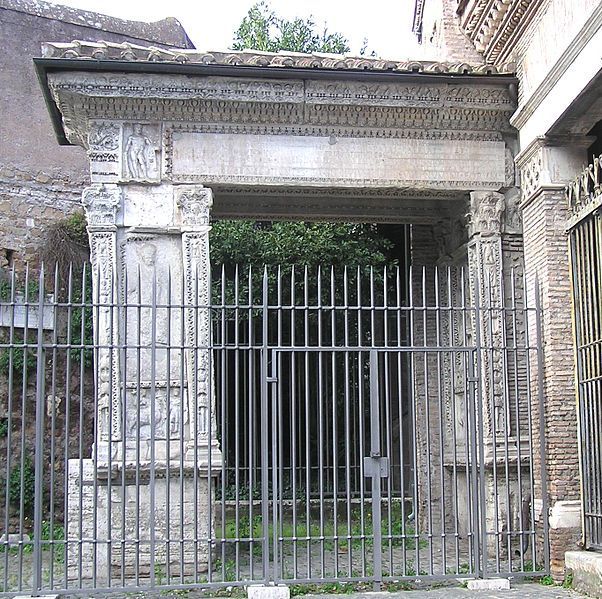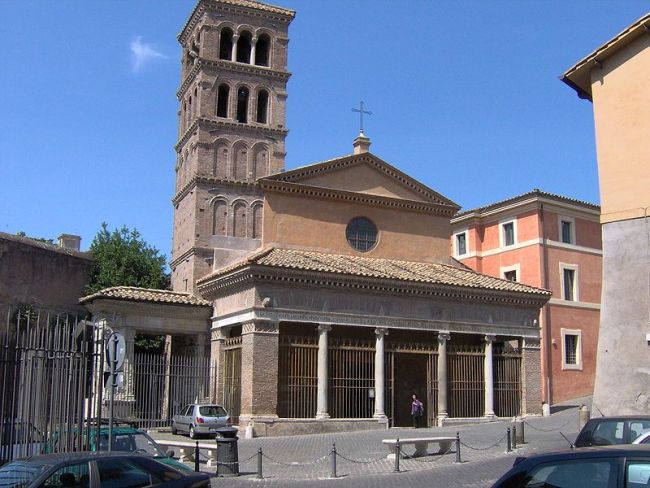
The Arch of the Argentarii, located in Rome, is an early third-century monument dedicated by merchants and money-changers to the royal dynasty of the empire, then the Severans. While very little is known for certain about the function of the arch in antiquity, the changes that scholars can observe in the artwork on the arch do represent the fascinating story of the emperors to whom the monument was dedicated. For example, the removal of any original depiction of Geta, brother to the emperor Caracalla (reigned 211-217) provides verification of this emperor’s rocky relationship with his brother, who was intended to rule the empire jointly with Caracalla by order of their father, Septimius Severus, as told by the third-century historian Cassius Dio.[1]
Dio writes: “Antoninus [Caracalla] wished to murder his brother on the feast of Cronus [Saturnalia], but he could not because his evil plan had already become too obvious to be concealed . . . Caracalla persuaded his mother to send for them both [Caracalla and Geta] in her home so that she could reconcile them. Trusting in this situation, Geta entered with him [his brother Caracalla] but when they were inside, some centurions rushed in together, as had been planned by Caracalla beforehand, and cut down Geta, who, when he saw them, had sought safety with his mother, hanging upon her neck and clinging to her chest, while moaning and crying out, “Mother who gave birth to me, Mother, help me! I am being slaughtered!”[2]
![Arch of Argentarii,<br><font size="-2">Detail “Arco degli Argentarii, internal side; Caracalla and figure [Geta] cancelled” by Panairjdde. Licensed under Creative Commons Attribution-Share Alike 2.0 Generic license via Wikimedia Commons - http://commons.wikimedia.org/wiki/File:Arco_degli_Argentarii_-_Panairjdde.jpg</font><br>](https://exhibits.library.villanova.edu/application/files/cache/thumbnails/8ccfe5d423efe63151c7353eeb11c81d.jpg)
The Arch of the Argentarii is then indirect evidence of the terrible cruelty that defined Roman rulers such as Caracalla in the period that ended the empire’s golden age.[3] More evidence of dynastic instability exists on the changes to names that are evident in the inscription (any time a family member fell out of favor and was killed his name would be removed from public monuments, known as damnatio memoriae). The text of the inscription as it survives today is as follows (the Latin text within brackets constitutes scholarly restorations):
IMP CAES L. SEPTIMIO SEVERO PIO PERTINACI AUG ARABIC ADIABENIC PARTH MAX FORTISSIMO FELICISSIMO PONTIF MAX TRIB POTEST XII IMP. XI COS III PATRI PATRIAE ET IMP. CAES. M. AURELIO ANTONINO PIO FELICI AUG. TRIB. POTEST. VII COS I[II P P PROCOS FORTISSIMO FELICISSIMOQUE PRINCIPI] ET IULIAE AUG MATRI AUG [N] ET CASTRORUM ET [SENATUS ET PATRIAE ET] IMP. CAES. M. AURELI ANTONINI PII FELICIS AUG [PARTHICI MAXIMI BRITTANNICI MAXIMI] ARGENTARI ET NEGOTIANTES BOARI HUIUS [LOCI QUI INVEHENT] DEVOTI NUMINI EORUM.[4]
“To the emperor and Caesar [Septimius Severus], Lucius Septimius Severus Pius Pertinax Augustus Arabicus Adiabenicus Parthicus, the greatest, bravest, and most fortunate, Pontifex Maximus, with tribunician power for the 12th time, victorious general for the 11th time, consul for the 3rd time, and father of his country and to the emperor and Caesar [Caracalla], Marcus Aurelius Antoninus Pius Felix Augustus, with tribunician power for the 7th time, consul for the 3rd time , father of his country, proconsul, bravest and most fortunate princeps [prince], and to Julia Augusta, mother of our Augustus, of the armies, of the senate, of the country, and of the emperor Caesar Marcus Aurelius Antoninus Pius Felix Augustus, conqueror of the greatest Parthians and the greatest Britons, the money-changers and merchants of this place [Forum Boarium] will dedicate [this arch], being devoted to their spirits.”


The arch itself is physically made of marble, with reliefs depicting subjects common to classical monumental art, such as mythological figures and the royal family. It was not a triumphal arch, like the most famous arches of Rome, but rather was most likely used as a gate to the Forum Boarium. There may have been statues of the Severans on top of the arch in antiquity as well, but if there were, they perished long ago. The primary reason that the Arch of the Argentarii survives today is its incorporation into the church of San Giorgio al Velabro in the seventh century A.D.[5]

While surviving evidence does not allow modern scholars to elaborately understand its construction or daily function, the Arch of the Argentarii remains a powerful testament to the historical Severan dynasty and the ways its members desired to be depicted among contemporaries.
[1] Ward et al (2010) 376.
[2] Dio 78.2.1-3; this is my own translation of the original Greek, not included here.
[3] Hunt et al (2012)198-199.
[4] Bellori (1690) Plate 6 detail.
[5] Platner (1929) 44.
Bellori, Giovanni Pietro. Veteres arcus Augustorm triumphis insignes ex reliquiis quae Romae adhuc supersunt : cum imaginibus triumphalibus restituti, antiquis nummis notisquae Io: Petri Bellorii illustrati nunc primum / per Io Iacobum de Rubeis. Rome: Ad Templum Sanctae Mariae de Pace, 1690.
Cassius Dio. Roman History. Epitome of Book 78 (Loeb Edition; Cambridge: Harvard University Press, 1914-1927).
Hunt, Lynn, Thomas R. Martin, Barbara H. Rosenwein, and Bonnie G. Smith. The Making of the West: Peoples and Cultures. 4th edition. Boston: Bedford St. Martin’s, 2012.
Platner, Samuel Ball. A Topographical Dictionary of Ancient Rome. Rev. Thomas Ashby. Oxford: Oxford University Press, 1929, p. 44.
Ward, Allen M., Fritz M. Heichelheim, and Cedric A. Yeo. A History of the Roman People. 5th edition. Boston, Prentice Hall, 2010.